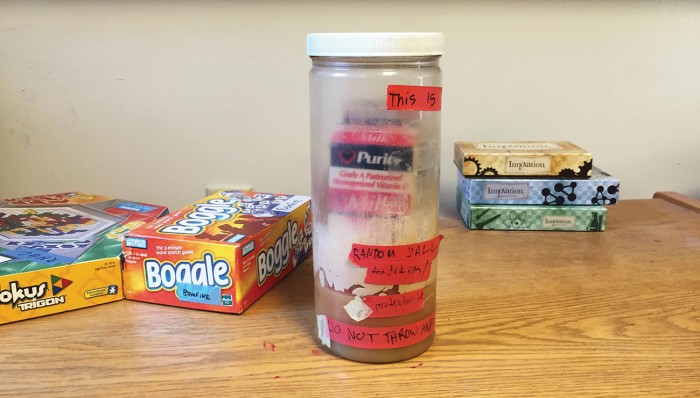For more than two decades, Random Hall residents have shared their living space with an unlikely—and slightly terrifying—presence known simply as the Milk. Since 1994, this carton of Grade A milk has migrated from floor to floor; since it no longer requires refrigeration, it has made appearances in the laundry room, on top of the piano, and in the common area.
Justin O. Cave ’98, the original owner of the Milk, purchased it in October of his freshman year in a half-hearted attempt to make mac and cheese. Life and Rush Week intervened, and the Milk sat neglected. Ten months past its expiration date, Cave rediscovered it and decided that his floor should celebrate its birthday. Then, he says, they were stuck with it. “We can’t throw it out just after we had a birthday party for it,” he recalls thinking. “That would just be rude!”
Interest in the Milk intensified in 1995 when Random residents campaigned for it to win that year’s Ugliest Manifestation on Campus (UMOC) award. They offered to bring the Milk to the competition, but “that argument ultimately did not win the day—something about hazardous materials,” says Cave. So residents took turns dressing up in a giant Milk costume to serve as its emissary. The Milk won that year, and “once that had happened, it became its own little celebrity,” he says.
And thus, the Milk was allowed to remain. When it ate through its carton soon after its birthday, Randomites began storing the carton in a plastic container. The Milk won UMOC again in 1998, 2000, and 2003. By then, it had become an integral part of Random Hall’s quirky, idiosyncratic community.

Nina Davis-Millis, housemaster of Random Hall, says the Milk is now a mostly harmless presence. “I don’t think it has any odor to it anymore. I am told that it used to smell very bad,” she says. “I definitely try not to get too close to it.”
In early 2014, the MIT Admissions Office received a 22-page application from the Milk, which was not offered a spot in the Class of 2019.
These days the brownish-orange liquid sits quietly and occasionally migrates from floor to floor. It’s doubtful that it still contains any of the chemical components that make up milk, although a few may still be intact, according to Steven C. Murphy, fluid milk expert in the Milk Quality Improvement Program at Cornell University. He adds that the Milk probably harbors living organisms in some form or another, “but it may have become so toxic or nutrient deficient that little growth is occurring and few actually survived,” he says.
Whether it’s toxic or not, Random Hall residents wouldn’t dream of getting rid of the Milk now. “We just think of it as a mascot—or millions of little mascots—run amok in there,” says Davis-Millis. “I guess you can think of it in terms of when good science goes bad, or as far as Random Hall goes, as appreciating the random moment.”
Cave insists that the Milk may have a few surprises left. “We actually did negotiate, on behalf of the people of Earth, a mutual nonaggression treaty with it,” he says. “At some point it will become sentient, and if it does, I hope that it’s kind and loving.”
Keep Reading
Most Popular
Large language models can do jaw-dropping things. But nobody knows exactly why.
And that's a problem. Figuring it out is one of the biggest scientific puzzles of our time and a crucial step towards controlling more powerful future models.
The problem with plug-in hybrids? Their drivers.
Plug-in hybrids are often sold as a transition to EVs, but new data from Europe shows we’re still underestimating the emissions they produce.
Google DeepMind’s new generative model makes Super Mario–like games from scratch
Genie learns how to control games by watching hours and hours of video. It could help train next-gen robots too.
How scientists traced a mysterious covid case back to six toilets
When wastewater surveillance turns into a hunt for a single infected individual, the ethics get tricky.
Stay connected
Get the latest updates from
MIT Technology Review
Discover special offers, top stories, upcoming events, and more.